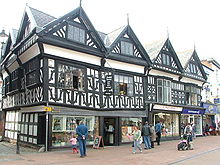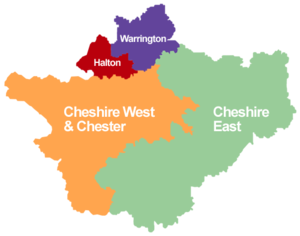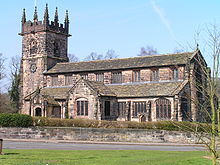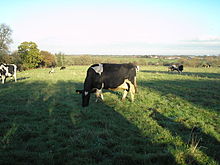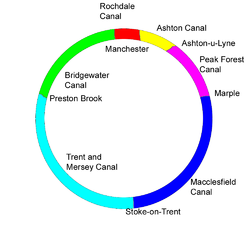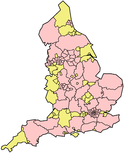- Cheshire
-
Cheshire 
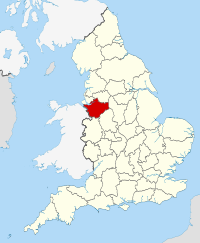
Geography Status Ceremonial county Origin Historic Region North West England Area
- TotalRanked 25th
2,343 km2 (905 sq mi)Admin HQ Chester ISO 3166-2 GB-CHS ONS code 13 NUTS 3 UKD22 Demography Population
- Total (2010 est.)
- DensityRanked 20th
1,009,300
431 /km2 (1,120 /sq mi)Ethnicity 98.3% White, 1.7% Other. Politics no county council Executive Members of Parliament - Graham Evans (C)
- Helen Jones (L)
- Andrew Miller (L)
- Stephen O'Brien (C)
- George Osborne (C)
- Stephen Mosley (C)
- David Mowat (C)
- Edward Timpson (C)
- Derek Twigg (L)
- Fiona Bruce (C)
- David Rutley (C)
Districts 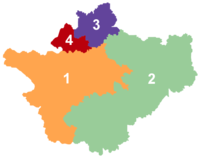
- Cheshire West and Chester (Unitary)
- Cheshire East (Unitary)
- Warrington (Unitary)
- Halton (Unitary)
Cheshire (
 /ˈtʃɛʃər/ or /ˈtʃɛʃɪər/; also known, archaically, as the County of Chester)[1] is a ceremonial county in North West England. Cheshire's county town is the city of Chester,[2] although its largest town is Warrington. Other major towns include Widnes, Congleton, Crewe, Ellesmere Port, Runcorn, Macclesfield, Winsford, Northwich, and Wilmslow.[3] The county is bordered by Merseyside and Greater Manchester to the north, Derbyshire to the east, Staffordshire and Shropshire to the south, and Flintshire and Wrexham in Wales to the west. The county is a part of the Welsh Marches.
/ˈtʃɛʃər/ or /ˈtʃɛʃɪər/; also known, archaically, as the County of Chester)[1] is a ceremonial county in North West England. Cheshire's county town is the city of Chester,[2] although its largest town is Warrington. Other major towns include Widnes, Congleton, Crewe, Ellesmere Port, Runcorn, Macclesfield, Winsford, Northwich, and Wilmslow.[3] The county is bordered by Merseyside and Greater Manchester to the north, Derbyshire to the east, Staffordshire and Shropshire to the south, and Flintshire and Wrexham in Wales to the west. The county is a part of the Welsh Marches.Cheshire's area is 2,343 square kilometres (905 sq mi) and its population is around 700,000[4]. Apart from the large towns along the River Mersey and the historic city of Chester, it is mostly rural, with a number of small towns and villages that support an agricultural industry. It is historically famous as a former principality and for the production of Cheshire cheese,[5] salt, bulk chemicals, and woven silk.
Contents
History
Toponymy
Cheshire's name was originally derived from an early name for Chester, and was first recorded as Legeceasterscir in the Anglo-Saxon Chronicles,[6] meaning the shire of the city of legions.[7] Although the name first appears in 980, it is thought that the county was created by Edward the Elder around 920.[7] In the Domesday Book, Chester was recorded as having the name Cestrescir (Chestershire), derived from the name for Chester at the time.[6] A series of changes that occurred as English itself changed, together with some simplifications and elision, resulted in the name Cheshire, as it occurs today.
Because of the historically close links with the land bordering Cheshire to the west, which became Wales, there is a history of interaction between Cheshire and Wales. The Domesday Book records Cheshire as having two complete Hundreds (Atiscross and Exestan) that later became entirely part of Wales. Additionally, another large portion of the Duddestan Hundred later became known as Maelor Saesneg when it was transferred to Wales.[8] For this and other reasons, the Welsh name for Cheshire (Swydd Gaerlleon)[9] is sometimes used within Wales and by Welsh speakers.
Administrative history
After the Norman conquest of 1066 by William I, dissent and resistance continued for many years after the invasion. In Cheshire in 1069 local resistance was finally overcome, and draconian measures were taken to impress the native Saxons with the futility of future resistance. Earl Edwin of Mercia along with other major landowners were made examples of, their properties confiscated and redistributed amongst Norman barons. King William created one of his barons, Hugh d'Avranches (nicknamed Hugh Lupus, or 'wolf') as Earl of Chester, ruling virtually autonomously in William's name and with his full authority, and Cheshire was thereby declared a County Palatine.
Cheshire in the Domesday Book (1086) was recorded as a larger county than it is today. It included two hundreds, Atiscross and Exestan, that later became part of Wales. At the time of the Domesday Book, it also included as part of Duddestan Hundred the area of land later known as Maelor Saesneg (which used to be a detached part of Flintshire) in Wales.[10] The area between the Mersey and Ribble (referred to in the Domesday Book as "Inter Ripam et Mersam") formed part of the returns for Cheshire.[11][12] Although this has been interpreted to mean that at that time south Lancashire was part of Cheshire,[12][13] more exhaustive research indicates that the boundary between Cheshire and what was to become Lancashire remained the River Mersey.[14][15][16] With minor variations in spelling across sources, the complete list of hundreds of Cheshire at this time are: Atiscross, Bochelau, Chester, Dudestan, Exestan, Hamestan, Middlewich, Riseton, Roelau, Tunendune, Warmundestrou and Wilaveston.[17]
In 1182 the land north of the Mersey became administered as part of the new county of Lancashire, thus resolving any uncertainty about the county in which the land "Inter Ripam et Mersam" was.[18] Over the years, the ten hundreds consolidated and changed names to leave just seven—Broxton, Bucklow, Eddisbury, Macclesfield, Nantwich, Northwich and Wirral.[19]
In 1397 the county had lands in the march of Wales added to its territory, and was promoted to the rank of principality. This was because of the support the men of the county had given to King Richard II, in particular by his standing armed force of about 500 men called the "Cheshire Guard". As a result the King's title was changed to "King of England and France, Lord of Ireland, and Prince of Chester". No other English county has been honoured in this way, although it lost the distinction on Richard's fall in 1399.[20]
Through the Local Government Act 1972, which came into effect on 1 April 1974, some areas in the north-west became part of the metropolitan counties of Greater Manchester and Merseyside.[21] Stockport (previously a county borough), Altrincham, Hyde, Dukinfield and Stalybridge in the north-east became part of Greater Manchester. Much of the Wirral Peninsula in the north-west, including the county boroughs of Birkenhead and Wallasey, joined Merseyside. At the same time the Tintwistle Rural District was transferred to Derbyshire. The area of Lancashire south of the Merseyside/Greater Manchester area, including Widnes and the county borough of Warrington, was added to the new non-metropolitan county of Cheshire.[22]
Halton and Warrington became unitary authorities independent of Cheshire County Council on 1 April 1998, but remain part of Cheshire for ceremonial purposes and also for fire and policing.[23]
A referendum for a further local government reform connected with an elected regional assembly was planned for 2004, but was abandoned – see Northern England referendum, 2004.
As part of the local government restructuring in April 2009, Cheshire County Council and the Cheshire districts were abolished and replaced by two new unitary authorities, Cheshire East and Cheshire West and Chester. The existing unitary authorities of Halton and Warrington were not affected by the change.
As part of a 2002 marketing campaign, the plant conservation charity Plantlife chose the cuckooflower as the county flower.
Buildings and structures
Prehistoric burial grounds have been discovered at The Bridestones, near Congleton (Neolithic) and Robin Hood's Tump, near Alpraham (Bronze Age).[24] The remains of Iron Age hill forts are found on sandstone ridges at several locations in Cheshire. Examples include Maiden Castle on Bickerton Hill, Helsby Hillfort and Woodhouse Hillfort at Frodsham. The Roman fortress and walls of Chester, perhaps the earliest building works in Cheshire remaining above ground, are constructed from purple-grey sandstone.[25]
The distinctive local red sandstone has been used for many monumental and ecclesiastical buildings throughout the county: for example, the medieval Beeston Castle, Chester Cathedral and numerous parish churches. Occasional residential and industrial buildings, such as Helsby Station, Helsby (1849), are also in this sandstone.
Many surviving buildings from the 15th to 17th centuries are timbered, particularly in the southern part of the county. Notable examples include the moated manor house Little Moreton Hall, dating from around 1450, and many commercial and residential buildings in Chester, Nantwich and surrounding villages.
Early brick buildings include Peover Hall near Macclesfield (1585), Tattenhall Hall (pre-1622), and the Pied Bull Hotel in Chester (17th century). From the 18th century, orange, red or brown brick became the predominant building material used in Cheshire, although earlier buildings are often faced or dressed with stone. Examples from the Victorian period onwards often employ distinctive brick detailing, such as brick patterning and ornate chimney stacks and gables. Notable examples include Arley Hall near Northwich, Willington Hall[26] near Chester (both by Nantwich architect George Latham) and Overleigh Lodge, Chester. From the Victorian era, brick buildings often incorporate timberwork in a mock Tudor style, and this hybrid style has been used in some modern residential developments in the county. Industrial buildings, such as the Macclesfield silk mills (for example, Waters Green New Mill), are also usually in brick.
Physical geography
Cheshire covers a boulder clay plain separating the hills of North Wales and the Peak District of Derbyshire (the area is also known as the Cheshire Gap). This was formed following the retreat of ice age glaciers which left the area dotted with kettle holes, locally referred to as meres. The bedrock of this region is almost entirely Triassic sandstone, outcrops of which have long been quarried, notably at Runcorn, providing the distinctive red stone for Liverpool Cathedral and Chester Cathedral.
The eastern half of the county is Upper Triassic Mercia Mudstone laid down with large salt deposits which were mined for hundreds of years around Northwich. Separating this area from Lower Triassic Sherwood Sandstone to the west is a prominent sandstone ridge known as the Mid Cheshire Ridge. A 55-kilometre (34 mi) footpath,[27] the Sandstone Trail, follows this ridge from Frodsham to Whitchurch passing Delamere Forest, Beeston Castle and earlier Iron Age forts.[28]
The highest point in Cheshire is Shining Tor on the Derbyshire/Cheshire border between Macclesfield and Buxton, at 559 metres (1,834 ft) above sea level. Prior to county boundary alterations in 1974, the county top was Black Hill (582 m (1,909 ft)) near Crowden in the far east of the historic county on the border with the West Riding of Yorkshire. Black Hill is now the highest point in West Yorkshire.
Demography
Population
Based on the Census of 2001, the overall population of Cheshire is 673,781, of which 51.3% of the population were male and 48.7% were female. Of those aged between 0–14 years, 51.5% were male and 48.4% were female; and of those aged over 75 years, 62.9% were female and 37.1% were male.
The population density of Cheshire is 32 people per km², lower than the North West average of 42 people/km² and the England and Wales average of 38 people/km². Ellesmere Port and Neston has a greater urban density than the rest of the county with 92 people/km².[29]
The population for 2021 is forecast to be 708,000.[30]
Ethnicity
Ethnic white groups accounted for 98% (662,794) of the population with 10,994 (2%) in ethnic groups other than white.
Of the 2% in non-white ethnic groups:
- 3,717 (34%) belonged to mixed ethnic groups
- 3,336 (30%) were Asian or Asian British
- 1,076 (10%) were Black or Black British
- 1,826 (17%) were of Chinese ethnic groups
- 1,039 (9%) were of other ethnic groups.[31]
Population change
Population totals for Cheshire Year Population Year Population Year Population 1801 124,570 1871 277,123 1941 431,335 1811 141,672 1881 303,315 1951 471,438 1821 167,730 1891 324,494 1961 533,642 1831 191,965 1901 343,557 1971 605,918 1841 206,063 1911 364,179 1981 632,630 1851 224,739 1921 379,157 1991 656,050 1861 250,931 1931 395,717 2001 673,777 Pre-1974 statistics were gathered from local government areas that now comprise Cheshire
Source: Great Britain Historical GIS.[32]Politics and administration
Current
Cheshire is a ceremonial county. This means that although there is no county-wide elected local authority, Cheshire has a Lord Lieutenant and High Sheriff for ceremonial purposes under the Lieutenancies Act 1997.
Local government functions apart from the Police and Fire/Rescue services are carried out by four smaller unitary authorities: Cheshire East, Cheshire West and Chester, Halton, and Warrington.
Policing and fire and rescue services are still provided across the County as a whole, but by unelected bodies. The Cheshire Police Authority and Cheshire Fire Authority consist of members of the four councils.
Transition from the previous (1974) arrangement
From 1 April 1974 the area under the control of the county council was divided into eight local government districts; Chester, Congleton, Crewe and Nantwich, Ellesmere Port and Neston, Halton, Macclesfield, Vale Royal and Warrington.[33][34] Halton (which includes the towns of Runcorn and Widnes) and Warrington became unitary authorities in 1998.[23][35] The remaining districts and the county were abolished as part of local government restructuring on 1 April 2009.[36] The Halton and Warrington boroughs were not affected by the 2009 restructuring.
On 25 July 2007, the Secretary of State Hazel Blears announced she was 'minded' to split Cheshire into two new unitary authorities, Cheshire West and Chester, and Cheshire East. She confirmed she had not changed her mind on 19 December 2007 and therefore the proposal to split two-tier Cheshire into two would proceed.
Cheshire County Council leader Paul Findlow, who attempted High Court legal action against the proposal, claimed that splitting Cheshire would only disrupt excellent services while increasing living costs for all. A widespread sentiment that this decision was taken by the European Union long ago has often been portrayed via angered letters from Cheshire residents to local papers. On 31 January 2008 The Standard, Cheshire & district newspaper, announced that the legal action had been dropped. Members against the proposal were advised that they may be unable to persuade the court that the decision of Hazel Blears was "manifestly absurd".
The Cheshire West and Chester unitary authority covers the area formerly occupied by the City of Chester and the boroughs of Ellesmere Port and Neston and Vale Royal; Cheshire East now covers the area formerly occupied by the boroughs of Congleton, Crewe and Nantwich, and Macclesfield. The changes were implemented on 1 April 2009.[37][38]
Congleton Borough Council pursued an appeal against the judicial review it lost in October 2007. The appeal was dismissed on 4 March 2008.[39]
Borders
The ceremonial county borders Merseyside, Greater Manchester, Derbyshire, Staffordshire and Shropshire in England along with Flintshire and Wrexham in Wales, arranged by compass directions as shown in the table. below. Cheshire also forms part of the North West England region.[40]
Neighbouring Authorities to the Ceremonial County 
Merseyside Merseyside/Greater Manchester Greater Manchester 
Flintshire 
Derbyshire  Cheshire
Cheshire 

Wrexham Shropshire Staffordshire Religion
In the 2001 Census, 81% of the population (542,413) identified themselves as Christian; 124,677 (19%) did not identify with any religion or did not answer the question; 5,665 (1%) identified themselves as belonging to other major world religions; and 1,033 belonged to other religions.[31]
The boundary of the Church of England Diocese of Chester follows most closely the pre-1974 county boundary of Cheshire, so it includes all of Wirral, Stockport, and the Cheshire panhandle that included Tintwistle Rural District council area.[41] In terms of Roman Catholic church administration, most of Cheshire falls into the Roman Catholic Diocese of Shrewsbury.[42]
Economy and industry
Cheshire has a diverse economy with significant sectors including agriculture, automotive, bio-technology, chemical, financial services, food and drink, ICT, and tourism. The county is famous for the production of Cheshire cheese, salt and silk.
A mainly rural county, Cheshire has a high concentration of villages. Agriculture is generally based on the dairy trade, and cattle are the predominant livestock. Land use given to agriculture has fluctuated somewhat, and in 2005 totalled 1558 km² over 4,609 holdings.[43] Based on holdings by EC farm type in 2005, 8.51 km² was allocated to dairy farming, with another 11.78 km² allocated to cattle and sheep.
The chemical industry in Cheshire was founded in Roman times, with the mining of salt in Middlewich and Northwich. Salt is still mined in the area by British Salt. The salt mining has led to a continued chemical industry around Northwich, with Brunner Mond based in the town. Other chemical companies, including Ineos (formerly ICI), have plants at Runcorn. The Shell Stanlow Refinery is at Ellesmere Port. The oil refinery has operated since 1924 and has a capacity of 12 million tonnes per year.[citation needed]
Crewe was once the centre of the British railway industry, and remains a major railway junction. The Crewe railway works, built in 1840, employed 20,000 people at its peak, although the workforce is now less than 1,000. Crewe is also the home of Bentley cars. Also within Cheshire are manufacturing plants for Jaguar and Vauxhall Motors in Ellesmere Port. The county also has an aircraft industry, with the BAE Systems facility at Woodford Aerodrome, part of BAE System's Military Air Solutions division. The facility designed and constructed Avro Lancaster and Avro Vulcan bombers and the Hawker-Siddeley Nimrod. On the Cheshire border with Flintshire is the Broughton aircraft factory, more recently associated with Airbus.
Tourism in Cheshire from within the UK and overseas continues to perform strongly. Over 8 million nights of accommodation (both UK and overseas) and over 2.8 million visits to Cheshire were recorded during 2003.[44]
At the start of 2003, there were 22,020 VAT-registered enterprises in Cheshire, an increase of 7% since 1998, many in the business services (31.9%) and wholesale/retail (21.7%) sectors. Between 2002 and 2003 the number of businesses grew in four sectors: public administration and other services (6.0%), hotels and restaurants (5.1%), construction (1.7%), and business services (1.0%).[44] The county saw the largest proportional reduction between 2001 and 2002 in employment in the energy and Water sector and there was also a significant reduction in the manufacturing sector. The largest growth during this period was in the other services and distribution, hotels and retail sectors.[44]
Cheshire is considered to be an affluent county.[citation needed] Due to Cheshire's proximity to the cities of Manchester and Liverpool, counter urbanisation is common. Cheshire West has a fairly large proportion of residents who work in Liverpool, while Cheshire East falls within Manchester's sphere of influence.
Education
See also: List of schools in Cheshire East; List of schools in Cheshire West and Chester; List of schools in Halton; List of schools in Warrington
All four local education authorities in Cheshire operate only comprehensive state school systems. When Altrincham and Sale were moved from Cheshire to Trafford in 1974, they took some former Cheshire selective schools. Today, there are two universities based in the county, the University of Chester and the Crewe campus of Manchester Metropolitan University.
Culture, media and sport
Cheshire has two league football teams, namely Crewe Alexandra and Macclesfield Town who both play in League Two. Chester City was also a League Two team until they were relegated to the Conference National in April 2009 and later dissolved. A new club, Chester F.C. was formed in 2010 and currently plays in the Northern Premier League Premier Division.
Cheshire also is represented in the highest level basketball league in the UK, the BBL, by the Cheshire Jets, formerly Chester Jets.
Warrington Wolves are the premier Rugby League team in Cheshire and play in the Super League. Widnes Vikings are currently in Super League from the 2012 season. There are also numerous junior clubs in the county, including Chester Gladiators.
Cheshire County Cricket Club is one of the clubs that make up the Minor counties of English and Welsh cricket.
The county has also been home to many notable sportsmen and athletes, including footballers Dean Ashton, Djibril Cissé, Peter Crouch, Seth Johnson, Michael Owen and Wayne Rooney. Other local athletes have included cricketer Ian Botham, marathon runner Paula Radcliffe, Great Britain Olympic oarsman Matthew Langridge, Shirley Strong, and mountaineer George Mallory, who died in 1924 on Mount Everest.
Each May, Europe's largest motorcycle event, the Thundersprint, is held in Northwich.[45]
Cheshire has also produced a military hero in Norman Cyril Jones, a World War I flying ace who won the Distinguished Flying Cross.[46]
The county has produced several notable musicians, including popular artists John Mayall (John Mayall & the Bluesbreakers),[47] Ian Astbury (The Cult), Tim Burgess (Charlatans) and Ian Curtis (Joy Division). Concert pianist Stephen Hough, singer Thea Gilmore and her producer husband Nigel Stonier also reside in Cheshire. The county has also been home to several writers, including Hall Caine (1853–1931), popular romantic novelist and playwright; Alan Garner; Victorian novelist Elizabeth Gaskell, whose novel Cranford features her home town of Knutsford; and most famously Lewis Carroll, born and raised in Daresbury, hence the Cheshire cat. Artists from the county include ceramic artist Emma Bossons and sculptor and photographer Andy Goldsworthy. Actors from Cheshire include Daniel Craig, the 6th James Bond; Dame Wendy Hiller; and Lewis McGibbon, best known for his role in Millions.
Local radio stations in the county include Dee 106.3, Heart and Gold for Chester and West Cheshire, Silk FM for the east of the county, Signal 1 for the south, Wire FM for Warrington, Wish FM, which covers Widnes, and community station Cheshire FM, which covers central Cheshire. The BBC covers the west with BBC Radio Merseyside, the north and east with BBC Radio Manchester and the south with BBC Radio Stoke. There were plans to launch BBC Radio Cheshire, but those were shelved in 2007 after a lower than expected BBC licence fee settlement.
Settlements
The county is home to some of the most affluent areas of Northern England, including Alderley Edge, Wilmslow, Prestbury, Tarporley and Knutsford, named in 2006 as the most expensive place to buy a house in the north of England. The former Cheshire town of Altrincham was in second place. The area is sometimes referred to as The Golden Triangle on account of the area in and around the above mentioned towns and villages.[48]
The cities and towns in Cheshire are:
Ceremonial county District Centre of administration Other Towns or Cities Cheshire Cheshire East (unitary) Sandbach Alsager, Bollington, Crewe, Congleton, Knutsford, Macclesfield, Middlewich, Nantwich, Wilmslow Cheshire West and Chester (unitary) Chester Ellesmere Port, Frodsham, Malpas, Neston, Northwich, Winsford Halton (unitary) Widnes Runcorn Warrington (unitary) Warrington Lymm Some settlements which were historically part of the county now fall under the counties of Derbyshire, Merseyside and Greater Manchester:[22][49][50][51]
Derbyshire Crowden, Newtown, Tintwistle, Whaley Bridge (western part), Woodhead Greater Manchester Altrincham, Bramhall, Bredbury, Cheadle, Cheadle Hulme, Dukinfield, Gatley, Hazel Grove, Hyde, Marple, Romiley, Sale, Stalybridge, Stockport, Wythenshawe Merseyside Bebington, Birkenhead, Heswall, Hoylake, Wallasey, West Kirby Transport
Rail and road
The main railway line through the county is the West Coast Main Line. Many trains call at Crewe (in the south of the county) and Warrington Bank Quay (in the north of the county) en route to London and Scotland, as well as Runcorn on the Liverpool branch of the WCML.
The major interchanges are:
- Crewe (the biggest station in Cheshire) for trains to London Euston and Scotland (via the WCML), Wales, The Midlands (Birmingham, Stoke and Derby) as well as suburban services to Manchester, Chester and Liverpool.
- Warrington stations (Central and Bank Quay) for suburban services to Manchester, Chester and Liverpool and regional express services to North Wales, London, Scotland, Yorkshire, the East Coast and the East Midlands
- Chester for urban services (via Merseyrail) to Liverpool Central, suburban services to Manchester, Warrington and rural Cheshire and express services to Llandudno, Holyhead, Birmingham, the West Midlands, London and Cardiff
In the east of Cheshire, Macclesfield station is served by Virgin Trains and CrossCountry, on the Manchester-London line. Services from Manchester to the south coast frequently stop at Macclesfield.
Cheshire has 3,417 miles (5,499 km) of roads, including 214 miles (344 km) of the M6, M62, M53 and M56 motorways, with 23 interchanges and four service areas. The M6 motorway at the Thelwall Viaduct carries 140,000 vehicles every 24 hours.[52]
Waterways
The Cheshire canal system includes several canals originally used to transport the county's industrial products (mostly chemicals). Nowadays they are mainly used for tourist traffic. The Cheshire Ring is formed from the Rochdale, Ashton, Peak Forest, Macclesfield, Trent and Mersey and Bridgewater canals.
The Manchester Ship Canal is a wide, 36-mile (58 km) stretch of water opened in 1894. It consists of the rivers Irwell and Mersey made navigable to Manchester for seagoing ships leaving the Mersey estuary. The canal passes through the north of the county via Runcorn and Warrington.
List of rivers and canals
- Bridgewater Canal
- River Bollin
- River Croco
- River Dane
- River Dee/Afon Dyfrdwy
- River Dean
- River Gowy
- River Goyt
- Macclesfield Canal
- Manchester Ship Canal
- River Mersey
- Shropshire Union Canal and the Llangollen branch
- Trent and Mersey Canal
- River Weaver and Weaver Navigation
- River Wheelock
See also
Notes and references
Notes
- ^ "Relationships / unit history of Cheshire". A Vision of Britain through Time website. http://www.visionofbritain.org.uk/relationships.jsp?u_id=10193850. Retrieved 2007-03-05.
- ^ "Cheshire County Council". Cheshire County Council website. http://www.cheshire.gov.uk/. Retrieved 2007-03-05.[dead link]
- ^ "Cheshire County Council Map". Cheshire County Council. Archived from the original on 2007-06-05. http://web.archive.org/web/20070605061858/http://www.cheshire.gov.uk/NR/rdonlyres/947210D0-96BD-429E-898D-3E952A4C8925/0/CheshireCountyMapforWeb.pdf. Retrieved 2007-03-05.
- ^ "Census 2001 – Population". Cheshire Census Consortium. Archived from the original on 2007-06-05. http://web.archive.org/web/20070605061912/http://www.cheshire.gov.uk/NR/rdonlyres/2BA86039-3905-4E03-B2CC-1A56FF239192/0/Population.pdf. Retrieved 2007-03-06.
- ^ Ingham, A. (1920). Cheshire: Its Traditions and History.
- ^ a b Harris, B. E. and Thacker, A. T. (1987). p. 237.
- ^ a b Crosby, A. (1996). page 31.
- ^ Harris, B.E. and Thacker, A.T. (1987). pp. 340–341.
- ^ Welsh dictionary entry for Cheshire. www.geriadur.net website (Welsh-English / English-Welsh On-line Dictionary ). Department of Welsh, University of Wales, Lampeter. Retrieval Date: 21 February 2008
- ^ Davies, R. (2000). The Age of Conquest: Wales 1063–1415.
- ^ Morgan (1978). pp.269c–301c,d.
- ^ a b Sylvester (1980). p. 14.
- ^ Roffe (2000)
- ^ Harris and Thacker (1987) write on page 252:
Certainly there were links between Cheshire and south Lancashire before 1000, when Wulfric Spot held lands in both territories. Wulfric's estates remained grouped together after his death, when they were left to his brother Aelfhelm, and indeed there still seems to have been some kind of connexion in 1086, when south Lancashire was surveyed together with Cheshire by the Domesday commissioners. Nevertheless, the two territories do seem to have been distinguished from one another in some way and it is not certain that the shire-moot and the reeves referred to in the south Lancashire section of Domesday were the Cheshire ones.
- ^ Phillips and Phillips (2002); pp. 26–31.
- ^ Crosby, A. (1996) writes on page 31:
The Domesday Survey (1086) included south Lancashire with Cheshire for convenience, but the Mersey, the name of which means 'boundary river' is known to have divided the kingdoms of Northumbria and Mercia and there is no doubt that this was the real boundary.
- ^ Harris, B. E., and Thacker, A. T. (1987); pages 340–341.
- ^ George, D. (1991). Lancashire.
- ^ "Cheshire ancient divisions". Vision of Britain website. http://www.visionofbritain.org.uk/relationships.jsp?u_id=10193850. Retrieved 2007-03-06.
- ^ Davies, R. R. 'Richard II and the Principality of Chester' in The Reign of Richard II: Essays in Honour of May McKisack, ed. F. R. H. Du Boulay and Caroline Baron (1971)
- ^ Jones, B. et al. (2004). Politics UK.
- ^ a b Local Government Act 1972
- ^ a b "The Cheshire (Boroughs of Halton and Warrington) (Structural Change) Order 1996". Office of Public Sector Information. http://www.opsi.gov.uk/si/si1996/Uksi_19961863_en_1.htm. Retrieved 2007-03-06.
- ^ "Cheshire County Council: Revealing Cheshire's Past". .cheshire.gov.uk. 2004-09-01. http://www2.cheshire.gov.uk/Archaeology/RCP/PrehistoricSitesToVisit.htm. Retrieved 2010-09-25.
- ^ "Images of England". Images of England. http://www.imagesofengland.org.uk/. Retrieved 2010-09-25.
- ^ "Detailed Record". Imagesofengland.org.uk. http://www.imagesofengland.org.uk/details/default.aspx?pid=1&id=55781. Retrieved 2010-09-25.
- ^ [1][dead link]
- ^ "Walking Cheshire's Sandstone Trail". http://www.sandstonetrail.co.uk/.
- ^ "Census 2001 – Population". Cheshire Census Consortium. Archived from the original on 2007-06-05. http://web.archive.org/web/20070605061912/http://www.cheshire.gov.uk/NR/rdonlyres/2BA86039-3905-4E03-B2CC-1A56FF239192/0/Population.pdf. Retrieved 2007-03-06.
- ^ "CCC Long Term Population Forecasts". Cheshire County Council. Archived from the original on 2007-06-05. http://web.archive.org/web/20070605061908/http://www.cheshire.gov.uk/NR/rdonlyres/F648E8B3-E5AF-4832-9AB5-619CACFA87B1/0/PopF1.pdf. Retrieved 2007-03-06.
- ^ a b "Key Statistics Interim Profile". Cheshire County Council. Archived from the original on 2007-06-05. http://web.archive.org/web/20070605061922/http://www.cheshire.gov.uk/NR/rdonlyres/71754661-E7D9-4ECD-B71C-6163FD3574D1/0/PopC4.pdf. Retrieved 2007-03-06.
- ^ A Vision of Britain through time. "Cheshire Modern (post 1974) County: Total Population". http://www.visionofbritain.org.uk/data_cube_page.jsp?data_theme=T_POP&data_cube=N_TOT_POP&u_id=10032957&c_id=10001043&add=N. Retrieved 2010-01-10.
- ^ Vision of Britain – Divisions of Cheshire
- ^ Cheshire County Council – Map of Cheshire districts
- ^ "The Lord Lieutenant of Cheshire". Cheshire County Council. Archived from the original on 2007-02-03. http://web.archive.org/web/20070203042519/http://www.cheshire.gov.uk/aboutcheshire/lord.htm. Retrieved 2007-03-06.
- ^ "Cheshire (Structural Changes) Order 2008". Opsi.gov.uk. http://www.opsi.gov.uk/si/si2008/uksi_20080634_en_1. Retrieved 2010-09-25.
- ^ "BBC News, 25 July 2007 – County split into two authorities". BBC News. 2007-07-25. http://news.bbc.co.uk/1/hi/england/staffordshire/6916055.stm. Retrieved 2010-09-25.
- ^ "The Cheshire (Structural Changes) Order 2008". Office of Public Sector Information. http://www.opsi.gov.uk/si/si2008/uksi_20080634_en_1. Retrieved 2009-02-25.
- ^ "Unitary legal fight over in 60 seconds". LocalGov.co.uk. http://www.localgov.co.uk/index.cfm?method=news.detail&ID=64451. Retrieved 2009-02-25.
- ^ "Local Authorities". Government Offices of the North West. http://www.gonw.gov.uk/gonw/OurRegion/LocalAuthorities/. Retrieved 2007-03-06.
- ^ Chester Diocese (Church of England). Official website. Retrieval Date: 30 September 2007.
- ^ Diocese of Shrewsbury (Roman Catholic). Official website. Retrieval Date: 30 September 2007.
- ^ "Agricultural Holdings – Land and Employment – Cheshire – 2002 to 2005". Cheshire County Council. Archived from the original on 2007-06-05. http://web.archive.org/web/20070605061926/http://www.cheshire.gov.uk/NR/rdonlyres/8AC07978-47FE-4BA6-8063-39F5AFB0978D/0/EcE3.pdf. Retrieved 2007-06-03.
- ^ a b c "Cheshire Economy (page 64)". Cheshire County Council. Archived from the original on 2007-06-05. http://web.archive.org/web/20070605061855/http://www.cheshire.gov.uk/NR/rdonlyres/5F4B2042-1BCB-4F74-B53B-6EE65E28372E/0/CheshireEconomy.pdf. Retrieved 2007-03-06.
- ^ "The Thundersprint". http://www.thundersprint.com/first_timers_guide.html. Retrieved 2011-05-12.
- ^ Shores, et al, p. 217.
- ^ John Mayall biographical details. www.johnmayall.com website. Retrieval Date: 21 February 2008.
- ^ "Why Cheshire fat cats smile". The Times. London. http://property.timesonline.co.uk/tol/life_and_style/property/buying_and_selling/article1087249.ece. Retrieved 2006-03-06.
- ^ Chandler, J. (2001). Local Government Today.
- ^ "Cheshire ancient county boundaries". Vision of Britain website. Archived from the original on 2007-05-06. http://web.archive.org/web/20070506230504/http://www.visionofbritain.org.uk/bound_map_page.jsp?first=true&u_id=10193850&c_id=10001043. Retrieved 2007-03-06.
- ^ "Cheshire 1974 boundaries". Vision of Britain website. Archived from the original on 2007-05-06. http://web.archive.org/web/20070506230240/http://www.visionofbritain.org.uk/bound_map_page.jsp?first=true&u_id=10032957&c_id=10001043. Retrieved 2007-03-06.
- ^ "Road policing". Cheshire Police website. http://www.cheshire.police.uk/showcontent.php?pageid=1071. Retrieved 2009-06-14.
Bibliography
- Crosby, A. (1996). A History of Cheshire. (The Darwen County History Series.) Chichester, UK: Phillimore & Co ISBN 0-85033-932-4.
- Harris, B. E., and Thacker, A. T. (1987). The Victoria History of the County of Chester. (Volume 1: Physique, Prehistory, Roman, Anglo-Saxon, and Domesday). Oxford: Oxford University Press. ISBN 0-19-722761-9.
- Morgan, P. (Ed.) (1978). Domesday Book. Volume 26: Cheshire. Chichester, Sussex: Phillmore and Company Limited. ISBN 0-85033-140-4.
- Phillips, A. D. M., and Phillips, C. B. (Eds.) (2002). A New Historical Atlas of Cheshire. Chester, UK: Cheshire County Council and Cheshire Community Council Publications Trust. ISBN 0-904532-46-1.
- Shores, Christopher; Franks, Norman; Guest, Russell (1990). Above the Trenches: A Complete Record of the Fighter Aces and Units of the British Empire Air Forces 1915-1920. Grub Street. ISBN 0948817194, 9780948817199.
- Sylvester, D. (1980). A History of Cheshire, (The Darwen County History Series.) (Second Edition, original publication date, 1971). London and Chichester, UK: Phillimore & Co. Ltd. ISBN 0-85033-384-9.
Further reading
- Beck, J. (1969). Tudor Cheshire. (Volume 7 of Cheshire Community Council Series: A History of Cheshire). Series Editor: J. J. Bagley. Chester, UK: Cheshire Community Council.
- Bu'Lock, J. D. (1972). Pre-Conquest Cheshire 383–1066. (Volume 3 of Cheshire Community Council Series: A History of Cheshire). Series Editor: J. J. Bagley. Chester, UK: Cheshire Community Council.
- Dore, R.N. (1966). The Civil Wars in Cheshire. (Volume 8 of Cheshire Community Council Series: A History of Cheshire). Series Editor: J. J. Bagley. Chester, UK: Cheshire Community Council.
- Driver, J. T. (1971). Cheshire in the Later Middle Ages 1399–1540. (Volume 6 of Cheshire Community Council Series: A History of Cheshire). Series Editor: J. J. Bagley. Chester, UK: Cheshire Community Council.
- Harris, B. E. (1979). 'The Victoria History of the County of Chester. (Volume 2). Oxford: Oxford University Press. ISBN 0-19-722749-X.
- Harris, B. E. (1980). 'The Victoria History of the County of Chester. (Volume 3). Oxford: Oxford University Press. ISBN 0-19-722754-6.
- Hewitt, H. J. (1967). Cheshire Under the Three Edwards. (Volume 5 of Cheshire Community Council Series: A History of Cheshire). Series Editor: J. J. Bagley. Chester, UK: Cheshire Community Council.
- Higham, N. J. (1993). The Origins of Cheshire. Manchester, UK: Manchester University Press. ISBN 0-7190-3160-5.
- Hodson, J. H. (1978). Cheshire, 1660–1780: Restoration to Industrial Revolution. (Volume 9 of Cheshire Community Council Series: A History of Cheshire). Series Editor: J. J. Bagley. Chester, UK: Cheshire Community Council. ISBN 0-903119-11-0.
- Husain, B. M. C. (1973). Cheshire Under the Norman Earls 1066–1237. (Volume 4 of Cheshire Community Council Series: A History of Cheshire). Series Editor: J. J. Bagley. Chester, UK: Cheshire Community Council.
- Morgan, V., and Morgan, P. (2004). Prehistoric Cheshire. Ashbourne, Derbyshire:Landmark Publishing Company. ISBN 1-84306-140-6.
- Scard, G. (1981). Squire and Tenant: Rural Life in Cheshire 1760–1900. (Volume 10 of Cheshire Community Council Series: A History of Cheshire). Series Editor: J. J. Bagley. Chester, UK: Cheshire Community Council. ISBN 0-903119-13-7.
- Scholes, R. (2000). The Towns and Villages of Britain: Cheshire. Wilmslow, Cheshire: Sigma Press. ISBN 1-85058-637-3.
- Starkey, H. F. (1990). Old Runcorn. Halton Borough Council.
- Sylvester. D., and Nulty, G. (1958). The Historical Atlas of Cheshire. (Third Edition) Chester, UK: Cheshire Community Council.
- Thompson, F. H. (1965). Roman Cheshire. (Volume 2 of Cheshire Community Council Series: A History of Cheshire). Series Editor: J. J. Bagley. Chester, UK: Cheshire Community Council.
- Tigwell, R. E. (1985). Cheshire in the Twentieth Century. (Volume 11 of Cheshire Community Council Series: A History of Cheshire). Series Editor: J. J. Bagley. Chester, UK: Cheshire Community Council.
- Varley, W. J. (1964). Cheshire Before the Romans. (Volume 1 of Cheshire Community Council Series: A History of Cheshire). Series Editor: J. J. Bagley. Chester, UK: Cheshire Community Council.
- Youngs, F. A. (1991). Guide to the Local Administrative Units of England. (Volume 1: Northern England). London: Royal Historical Society. ISBN 0-86193-127-0.
External links
- Cheshire Lieutenancy
- Office of National Statistics – 2001 Bicentenary – Cheshire
- Discovercheshire website - council maintained recreational routes and country parks
- Cheshire Market Towns - council maintained guide to Cheshire's Market Towns
- Cheshire at the Open Directory Project
Ceremonial county of Cheshire Unitary authorities Major settlements Alsager • Birchwood • Bollington • Chester • Congleton • Crewe • Ellesmere Port • Frodsham • Knutsford • Macclesfield • Middlewich • Nantwich • Neston • Northwich • Poynton • Runcorn • Sandbach • Warrington • Widnes • Wilmslow • Winsford
See also: List of civil parishes in CheshireRivers Topics History • Museums Districts of North West England
Districts of North West EnglandCheshire 
Cumbria Allerdale • Barrow-in-Furness • Carlisle • Copeland • Eden • South Lakeland
Greater Manchester Lancashire Blackburn with Darwen • Blackpool • Burnley • Chorley • Fylde • Hyndburn • Lancaster • Pendle • Preston • Ribble Valley • Rossendale • South Ribble • West Lancashire • Wyre
Merseyside 1974–1996 ← Counties of England → current - Bedfordshire
- Berkshire
- City of Bristol
- Buckinghamshire
- Cambridgeshire
- Cheshire
- Cornwall
- Cumbria
- Derbyshire
- Devon
- Dorset
- Durham
- East Riding of Yorkshire
- East Sussex
- Essex
- Gloucestershire
- Greater London
- Greater Manchester
- Hampshire
- Herefordshire
- Hertfordshire
- Isle of Wight
- Kent
- Lancashire
- Leicestershire
- Lincolnshire
- City of London
- Merseyside
- Norfolk
- Northamptonshire
- Northumberland
- North Yorkshire
- Nottinghamshire
- Oxfordshire
- Rutland
- Shropshire
- Somerset
- South Yorkshire
- Staffordshire
- Suffolk
- Surrey
- Tyne and Wear
- Warwickshire
- West Midlands
- West Sussex
- West Yorkshire
- Wiltshire
- Worcestershire
Categories:- Cheshire
- English unitary authorities created in 2009
- Unitary authorities of England
- Former non-metropolitan counties
- North West England
- NUTS 2 statistical regions of the United Kingdom
Wikimedia Foundation. 2010.

